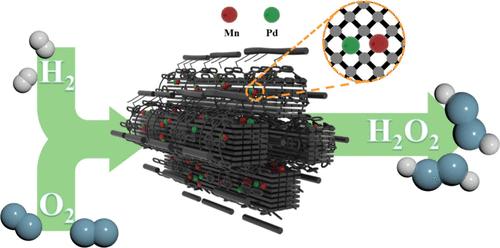Manganese–Palladium Dual-Atom Catalyst Boosts Direct H2O2 Synthesis beyond 2 wt % at Atmospheric Conditions
IF 11.3
1区 化学
Q1 CHEMISTRY, PHYSICAL
引用次数: 0
Abstract
Direct synthesis of hydrogen peroxide (H2O2) from H2 and O2 is appealing due to its nonpolluting nature, yet it is still very challenging to meet both high productivity and selectivity. In this work, a simple strategy was developed to synthesize a highly efficient dual-atom catalyst with a Mn atom inherited from nature biomass and a Pd atom artificially synthesized, which boosts a very high H2O2 productivity of 46,798 mmol gPd–1 h–1 and high selectivity of 89% even under atmospheric conditions (1 atm, 25 °C). Such high-efficiency catalysis enabled the production of a H2O2 solution with concentration beyond 2 wt %, which has not been achieved in earlier work. Experimental characterizations revealed the great H2 dissociation capability on the Pd–Mn/SMC (SMC = sylvestris mesoporous carbon) catalyst that was responsible for the high productivity. Theoretical calculations confirmed the favorable hydrogenation of undissociated O2 to H2O2 on the Pd–Mn dual-atom structure, which thus achieved high selectivity. Overall, this work provides a simple perspective on the utilization of natural species in biomass for single-atom structure fabrication and catalyst development for emerging applications.

锰钯双原子催化剂可在大气条件下促进直接 H2O2 合成,使合成量超过 2 重量百分比
从 H2 和 O2 直接合成过氧化氢(H2O2)因其无污染的特性而备受青睐,但要同时满足高生产率和高选择性的要求仍然非常具有挑战性。在这项工作中,我们开发了一种简单的策略来合成高效的双原子催化剂,其中一个锰原子来自自然界的生物质,另一个钯原子则是人工合成的,即使在大气条件下(1 atm,25 °C),这种催化剂也能提高 46,798 mmol gPd-1 h-1 的极高 H2O2 生产率和 89% 的高选择性。这种高效催化作用使得生产出的 H2O2 溶液浓度超过了 2 wt %,而这是之前的工作所无法实现的。实验表征显示,Pd-Mn/SMC(SMC = 锡中间多孔碳)催化剂具有很强的 H2 解离能力,这是产生高生产率的原因。理论计算证实,Pd-Mn 双原子结构有利于将未离解的 O2 加氢为 H2O2,从而实现高选择性。总之,这项工作为利用生物质中的天然物种进行单原子结构制造和催化剂开发的新兴应用提供了一个简单的视角。
本文章由计算机程序翻译,如有差异,请以英文原文为准。
求助全文
约1分钟内获得全文
求助全文
来源期刊

ACS Catalysis
CHEMISTRY, PHYSICAL-
CiteScore
20.80
自引率
6.20%
发文量
1253
审稿时长
1.5 months
期刊介绍:
ACS Catalysis is an esteemed journal that publishes original research in the fields of heterogeneous catalysis, molecular catalysis, and biocatalysis. It offers broad coverage across diverse areas such as life sciences, organometallics and synthesis, photochemistry and electrochemistry, drug discovery and synthesis, materials science, environmental protection, polymer discovery and synthesis, and energy and fuels.
The scope of the journal is to showcase innovative work in various aspects of catalysis. This includes new reactions and novel synthetic approaches utilizing known catalysts, the discovery or modification of new catalysts, elucidation of catalytic mechanisms through cutting-edge investigations, practical enhancements of existing processes, as well as conceptual advances in the field. Contributions to ACS Catalysis can encompass both experimental and theoretical research focused on catalytic molecules, macromolecules, and materials that exhibit catalytic turnover.
 求助内容:
求助内容: 应助结果提醒方式:
应助结果提醒方式:


